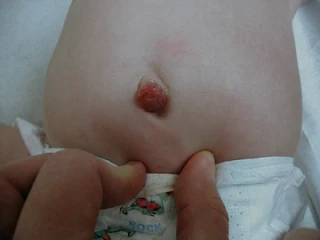Umbilical Granuloma
Introduction
Umbilical granuloma is a common benign condition that presents in infancy. It is usually noticed as a mass of red, friable granulation tissue at the base of the umbilical stump after the cord separates in the first few days after birth.
- Additional symptoms may include oozing, the presence of sticky mucus and mild irritation of the skin around the navel.
- However, they occasionally become infected.
While congenital conditions, such as patent urachus and persistent vitello intestinal duct, can mimic umbilical granuloma, they present with discharge of urine or faeces from the umbilicus.
Treatment
Currently, there is no clear consensus on the treatment modality of umbilical granuloma.
- Many centres in the UK recommend the use of common salt twice daily for 2 days as the first line therapy of umbilical granulomas.
- The granuloma and the surrounding skin were cleaned before with normal saline. Apply a small pinch of the table or cooking salt onto the umbilical granuloma. Cover the area with a gauze dressing and secure it in place for 30 minutes. This should be repeated twice a day for at least two days. In approximately two or three days, the granuloma is expected to reduce in size, change colour and dry off. Over the next few days, the area will gradually heal.
Silver nitrate or Copper sulphate
- Topical 75% silver nitrate is usually applied by a wooden applicator with premounted silver nitrate. The lesion is treated once or twice a week for several weeks, but generally only a few applications are required for successful treatment.
- A pinch of copper sulphate powder is applied over the umbilical granuloma and cover the area with sterile gauze and adhesive tapes and held it in place for 10 minutes. Thereafter, the lesion would be cleaned using cotton ball soaked in boiled water/normal saline.
- There are case reports of burning of the surrounding skin with their application, and therefore, will need to be cautiously applied by experienced clinicians.
- The use of petroleum jelly or liquid paraffin to protect the surrounding skin during their application may be beneficial.
Potent steroids
- Limited data suggest that topical clobetasol propionate cream is successful in treating umbilical granulomas.
- Application of potent steroids for 3-4 weeks on highly vascular granulomatous tissue may result in systemic absorption and suppression of the hypothalamic-pituitary-adrenal (HPA) axis, local side effects such as skin hypopigmentation and atrophy, and infections.
Cryocautery or Electrocautery
- While efficacious, cryocautery needs cryogenic nitrous oxide as a refrigerant and sophisticated equipment. Hence it is a less preferable option to treat umbilical granuloma.
- Electrocautery was associated with foul-smelling discharge in a significant proportion of infants in one study, which can be mistaken with local infection.
- Both cryocautery and electrocautery carry the potential risk of burns to the surrounding skin, and therefore, caution is needed while using them.
Surgical removal
- Can be considered if other treatment options have failed or inappropriate.
External Links
- HUSM Dec 2022 Newsletter
- Management of umbilical granuloma in infants: A systematic review of randomised controlled trials, 2021
- Salt Treatment for Umbilical Granuloma – An Effective, Cheap, and Available Alternative Treatment Option: Case Report, 2020
- Effectiveness of table salt versus copper sulphate in treating umbilical granuloma: A pilot randomized controlled trial, 2022

Comments
Post a Comment